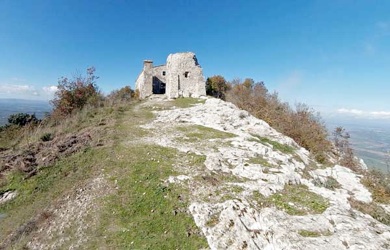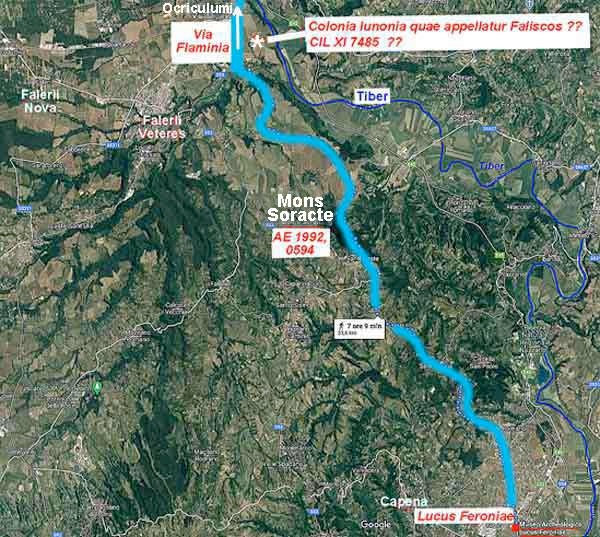Latin Cults
Cult of Soranus Apollo


Latin Cults
Cult of Soranus Apollo

Church of San Silvestro on the summit of Monte Soratte
The only surviving evidence for the cult dedicated to a god called Soranus Apollo in Italy comes from two inscriptions that were found on or near Monte Soratte (mons Soracte), some 10 km (6.2 mi) south east of Civita Castellana (Falerii Veteres):
✴AE 1992, 0594, which is inscribed on what had probably been the marble base of a small votive offering, has been dated to the 1st century AD. It reads:
Sorano/ Apollini/ d(onum) d(edit)/ Ti. Caei(us) Atim[etus
It was found near the church of San Silvestro on the summit of the mountain and is now in the sanctuary of Santa Maria delle Grazie below.
✴CIL XI 7485, which was also inscribed on what had probably been the marble base of a small votive offering,no longer survives. It reads:
C. Varius Hermes/ Sancto Sorano/ Apollini pro sal(ute) sua ...
According to Ivan Di Stefano Manzell (referenced below, 1992, at p. 162), it was found at Passo della Regina, near Via Flaminia at the foot of the mountain (see below) that was owned by the Trocci family and was initially preserved in Palazzo Trocchi (now Palazzo Canforo) at Civita Castellana.
Cult of Apollo on Mons Soracte
Although the name Soranus Apollo is not recorded in the surviving literature, the find spots of these two coins indicate that this was the cult of Apollo of mons Socrate, which Virgil (ca. 19 BC) described in the ‘Aeneid’: during an archaic battle in which Arruns, an ally of Aeneas, set out to kill the Volscian warrior princess Camilla, he first sought the aid of Apollo of mons Soracte with the following prayer:
“Apollo, highest of the gods (summe deum), guardian of holy Soracte (sancti custos Soractis), we are your foremost worshippers. The blaze of the pine wood pile is fed for us while we, your devotees (cultores), pass through the fire in strength of faith and plant our steps on the deep embers. Almighty father (pater ... omnipotens), grant that this disgrace [i.e., the threat from Camilla] be effaced by our arms”, (‘Aeneid’, 11: 785, based on the translation by Henry Rushton Fairclough, referenced below, at p. 291).
Servius (4th century AD), in his commentary on this passage (‘ad Aeneid’, 11: 785), glossed ‘summe deum’ as Jupiter. Massimilliano di Fazio (referenced below, 2013b, at p. 235-6) observed that:
“The god that the young Arruns invokes is not a ‘normal" Apollo: he is the highest of the gods and the guardian of mons Soracte. ... Servius’ commentary seems [to indicate a link] between Soranus, Apollo and Jupiter. In reality, [Virgil probably envisaged] a single [summe deum] whom the Faliscans and Capenates knew as Soranus, and whose characteristics were such that, under Roman influence, [he became] ... assimilated as a young Jupiter ...”, (my translation).
Virgil characterised Arruns as one of the cultores of Apollo of Mount Soracte, which probably indicated that he belonged to a group of worshippers who were formally associated with the cult. Virgil also described a ritual that the cultores performed in the honour of the god, which involved their walking through fire. Pliny the Elder (ca. 79 AD) explained that these cultores came from:
“... a few families in the territory of Faleri ... named the Hirpi, [and] walk over a charred pile of logs without being scorched at the yearly sacrifice to Apollo near Mount Soracte (ad montem Soracte). They therefore enjoy exemption from military service and all other burdens under a perpetual decree of the Senate”, (‘Natural History’, 7: 192, translated by Harris Rackham, referenced below, at p. 519).
Servius (‘ad Aeneid’, 11: 785) gave an exotic account of the origins of this ritual, much of which need not detain us: the salient points can be summarised as follows:
✴sacrifice to Dis Pater was originally performed on the mountain because it was sacred to the chthonic Di Manes;
✴according to tradition, the fire walking ritual was introduced after one such sacrifice was interrupted when wolves stole the entrails of the sacrificed victim from the fire; and
✴the cultores who performed the ritual were called hirpi Sorani and, since hirpi was the Sabine word for wolves and Soranus was the local name for Dis Pater (Ditis pater Soranus vocatur), they were the wolves of Dis Pater, the god of the underworld (whom the Greeks called Hades).
Massimilliano di Fazio (referenced below, 2013, at p. 238) argued that the enormity of the wolves’ putative theft the entrails of the sacrificed animal arose specifically because it had been sacrificed to Dis Pater: in this context, he cited John Scheid (referenced below, 2005, at pp. 261-2), who established that, according to tradition, the archaic lud Tauri had been established in Rome in order to propitiate Dis Pater after some parts of the bulls that had been sacrificed to him had subsequently been sold for human consumption, because animals sacrificed to the gods of the underworld belonged entirely to the divine recipients. In other words, for Servius, the hirpi Sorani performed the fire-walking ritual in propitiation for the wolves’ violation of the sacrificial remains that had belonged to Soranus/ Dis Pater.
Di Fazio (as above, citing Giovanni Colonna, referenced below, in a paper that I have not been able to consult directly) argued that that three of the gods named by Servius, Soranus, Apollo and Dis Pater, probably derived from Suri, a god of the underworld who was recorded in Etruscan inscriptions from at least the 6th century BC: he was known by the Faliscans as Soranus (Roman Dis Pater) and at Cumae as Aplu, an underworld version of Apollo. On this hypothesis, the Etruscan Suri gave his name to both Soranus (applied to Apollo) and Soracte (applied to his mountain).
Strabo (ca. 7 BC) associated the fire-walking ritual with Feronia and her sanctuary:
“The city of Feronia, at the foot of Mount Soracte, is named for a certain native goddess who is greatly honoured by the surrounding peoples. Her sacred precinct is in the place, and it has remarkable ceremonies: for, those who are possessed by this goddess walk with bare feet through a great heap of embers and ashes without suffering, and a multitude of people come together at the same time, for the sake not only of attending the festival, which is held here every year, but also of seeing the aforesaid spectacle”, (‘Geography’, 5: 2: 9).
Strabo is the only one of our surviving sources who claimed that the ritual was performed at the Lucus Feroniae, by people who were ‘possessed’ by Feronia (which could mean either that they were devoted to Feronia or that they belonged in some way to her sanctuary). Scholars generally agree that he was mistaken in locating the ritual here: for example, John Scheid (referenced below, 2016, at p. 81-2) suggested that he had taken some of his information from a putative document in which the Lucus Feroniae and the sanctuary of Soranus Apollo of Mount Soracte had both been assigned to the new triumviral colony at Lucus Feroniae.
However, it is possible that Lucus Feroniae was not the only colony founded near Mount Soracte at this time:
✴Pliny the Elder recorded another colony at Falisca quae cognominatur Etruscorum; and
✴the Liber Coloniarum recorded that land:
“... at Colonia Iunonia quae appellatur Faliscos was allocated by triumvirs ...”, (see Brian Campbell, referenced below, at pp. 170-1).
Campbell observed (at note 43, p. 408) that the name ‘Iunonia’ probably derived from the local cult of Juno Curitis, and its inclusion here adds weight to the hypothesis that this was a reference to a triumviral colony. Ivan Di Stefano Manzell (referenced below, 1990, at p. 354) argued that the title ‘colonia’ here:
“... does not, as far as we know, indicate a legal entity, but rather to the simple nucleus of veteran viritane settlers, probably subsequent to the expropriation of land [in the triumviral period] ...”, (my translation).
At the time that these two authors were writing, there was no known archeological evidence for this putative colony. However, more recently, Gabriele Cifani (referenced below, at pp. 27-36) published evidence for a pattern of land division in the plain at Gargarasi (to the northeast of Falerii Veteres, between a surviving stretch of Via Flaminia and the Tiber) that probably indicated the viritane settlement of Roman citizens here on land that was confiscated after the destruction of Falerii Nova in 241 BC: he illustrated (at figure 10, p. 34 and figure 11, p. 35) a pattern of allotments in modules of 8 actus along Via Flaminia, which had been built some twenty years later. He also noted (at p. 36) that the reference in the Liber Coloniarum (above) of boundary markers set at 240 and 480 pedes (equal to 2 and 4 actus), implicitly refers to submultiples of the 8 actus modules. In other words, the triumviral Colonia Iunonia recorded in the Liber Coloniarum could have been located on this centuriated area. A passage by Strabo provides some support for this hypothesis: having included Falerii and ‘Faliscum’ in a list of small towns in Etruria, he observed that:
“Some ... call the Falerii, not ‘Etruscans’ but ‘Falisci’, a special and distinct tribe; again, others call Faliscum a city with its own language while, for others. it refers to Aequum Faliscum, which is situated on Via Flaminia, between Ocriculum and Rome”, (‘Geography’, 5: 2: 9).
It is possible that the inscription CIL XI 7485, which was apparently found at Passo della Regina, near Via Flaminia, originally came from this colony.

Footpath from Lucus Feroniae, over Monte Soratte
Adapted from Google Maps
Read more:
Cifani G., “Per una Definizione dei Falisci, tra Identità, Cultura e Territorio”, in:
Cifani G. (editor), “Tra Roma e l’Etruria: Cultura, Identità e Territorio dei Falisci”, (2013) Rome, at pp. 1-54
Di Fazio M.(2013a), “Feronia. Spazi e Tempi di una Dea dell'Italia Centrale Antica”, (2013) Rome
Di Fazio M.(2013b), “Gli Hirpi del Soratte”, in:
Cifani G. (editor), “Tra Roma e l’Etruria: Cultura, Identità e Territorio dei Falisci”, (2013) Rome, at pp. 231-64
Di Fazio M., “Feronia. The Role of an Italic Goddess in the Process of Cultural Integration in Republican Italy”, in:
Roselaar S. (editor), “Processes of Integration and Identity Formation in the Roman Republic”, (2012) Leiden and Boston, at pp. 337-54
Colonna G., “L’ Apollo di Pyrgi, Sur/Suri (il ‘Nero’) e l’Apollo Sourios”, Studi Etruschi, 63 (2009) 101-34
Scheid J., “Rome et les Grands Lieux de Culte d’ Italie”, in:
Vigourt A. et al. (editors), “Pouvoir et Religion dans le Monde Romain: en Hommage à Jean-Pierre Martin”, (2006) Paris, pp. 75-88
Scheid J., “Quand Faire c'est Croire: Les Rites Sacrificiels des Romains”, (2005) Paris
Campbell, B., “The Writings of the Roman Land Surveyors: Introduction, Text, Translation and Commentary”, (2000) London
Boccali L., “Esempio di Organizzazione delle Fonti Antiche per la Ricostruzione del Quadro della Vita Religiosa di una Città e del suo Territorio in Età Preromana e Romana: Tarracina”, Cahiers du Centre Gustave Glotz, 8:1 (1997) 181–222
Di Stefano Manzella I., “Nuova Dedica a Soranus Apollo e Altre Iscrizioni dal Soratte”, Mélanges de l'École Française de Rome. Antiquité, 104:1 (1992) 159-67.
Di Stefano Manzella I., “Lo Stato Giuridico di Falerii Novi dalla Fondazione al III Secolo d.C.”, in:
Maetzke G. et al. (editors), “La Civiltà dei Falisci: Atti del XV Convegno di Studi Etruschi ed Italici, Civita Castellana, 28-31 Maggio 1987”, (1990) Florence, at p. 341-68
Keppie L., “Colonisation and Veteran Settlement in Italy, 47–14 BC”, (1983) Rome
Rackham H. (translator), “Pliny: Natural History, Volume II, Books 3-7”, (1942) Cambridge MA
Rushton Fairclough H. (translator), “Virgil: Aeneid, Books 7-12; Appendix Vergiliana”, (1918) Cambridge MA
Warde Fowler W., “Roman Festivals of the Period of the Republic”, (1899) London
Return to Rome in the Early Republic (509 - 241 BC)